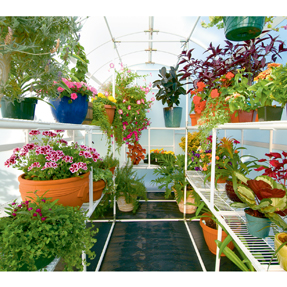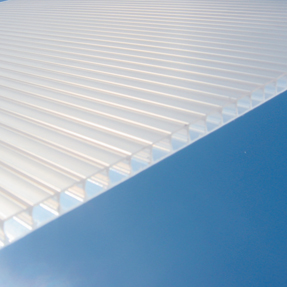How to Heat Your Greenhouse Cheaply
By Michelle Moore

Most of us at one time or another as kids used a magnifying glass to some devious means. (I may know of a few adults who still do). Our objective may have been to start leaves on fire or even to give someone a "hot flash". At the time we probably didn't realize we were harnessing one of our planet's most powerful forces. We also probably didn't realize that we could use that power for far more honorable means to provide comfort, to save our natural resources, or to help our garden grow and to eat better. Truth be told, if we did know it, at the time we probably didn't really care. Starting things on fire was more fun.
Harnessing the Power of the Sun
In 214 B.C. a scientist, Archimedes, harnessed the sun's power for warfare when he directed solar power onto the masts of invading roman ships. The intense rays set the sails on fire and staved off the invasion. Since Archimedes, many of the most progressive thinkers have harnessed the power of the sun. Socrates built the first known solar home. He dug his home into the ground with large Southern facing windows and a heavily insulated Northern wall. Leonardo De Vinci advocated using solar power for heating as have many others. These great thinkers were just a few of those who believed in power of solar energy. The potential remains untapped, yet benefiting from solar power is surprisingly easy and inexpensive.
In 1970, the average cost of power in the US was 2.2 cents per kilowatt hour (kWh). Today that average cost is 16.88 cents. The cost of power varies drastically across the country with highs as much as 47.5 cents. Collecting solar heat could reduce traditional greenhouse heating costs by as much as 30% to 40% just by increasing your thermal mass and using an insulated covering.

Greenhouses by their very nature are solar structures, heated cheaply by the sun. Greenhouses harness the light and warmth of the sun, and then trap the heat inside the structure to create an environment (hopefully) more conducive to plant growth than the outside world. The effect is similar to that of our atmosphere which traps sunlight and warms the earth. Greenhouses use what is referred to as passive solar. Passive solar is simply utilizing natural forces and southern exposure for heat.
Believe it or not, passive solar structures may even aid in cooling if designed properly. Passive solar heating does not require expensive or fancy equipment nor does it require a lot of knowledge to do. In fact, just about everyone experiences passive solar radiation on a summer day when they park their car in the sun. If the windows are left up, it's only a short amount of time before the inside temperate of the car reaches unbearable and even dangerous temperatures. That's certainly not the image you want for a greenhouse environment, but the example certainly illustrates how powerful the sun can be.
Benefits of an energy efficient greenhouse
Creating an energy efficient greenhouse does not happen without a little work and planning but it's not difficult. Here is who will benefit from improving their solar greenhouse. Anyone who:
Four Easy Tips to Heat Your Greenhouse Cheaply:
1. Maximize your greenhouses southern orientation
Take a look at your yard and the winter sun. Orient the longest side of your greenhouse facing as much due South as possible. Ideally you
want to have as much of the surface area as possible absorbing the sun.
Some people cannot put a greenhouse on the South side of their property due to space constraints, accessibility or other factors. If you don't have full sunlight, try to maximize as much light as possible.
Keep in mind that the sun is lower on the horizon in winter months and the most intense solar energy will hit the southern side of the greenhouse. Ideally the peak of the greenhouse will run along an East-West axis (example, front of greenhouse facing east, back facing west) to maximize daily collection. The idea is to collect as many of the warm rays as possible between the hours of 10:00 am to 2:00 pm., which provide the greatest amount of solar radiation (1).
2. Increase thermal mass to retain free heat in the greenhouse

There are several commonly used materials for increasing thermal mass: stone, concrete and water. Gravel makes an excellent flooring for the greenhouse that increases the thermal mass and also allows water to drain.
For additional thermal mass, water is an excellent mode of heat storage because it distributes the heat very evenly and releases it slowly. Large containers of water in a greenhouse will radiate heat all night, long after the last flickers of evening light fade. Warmth emitted from solar water containers is a slow, subtle, even heat that helps to maintain even greenhouse temperatures.
Note: five gallon plastic buckets or 30 gallon barrels work nicely in a greenhouse (2). Vessels are filled ¾ of the way with water then capped off tightly to prohibit evaporation and humidity. Smaller buckets are easily arranged to create a nice shelf, while large barrels also make nice plant stands.
Black plastic works well for storage containers. Black will absorb most of the radiation hitting its surface transferring the heat to the water.
Stainless and copper vessels work as well. They will heat much faster and transfer greater heat intensity to the water which absorbs more heat as a result. Metal containers may add undue expense and be difficult to find. I have not tried metal containers, but think it would be interesting to see a side by side test.
3. Use a reflective surface to capture more sun
Directing the most light possible to the thermal mass can significantly increase the heating capacity. Samuel Pierpont Langley, an astrophysicist, in California conducted a series of solar experiments on Mt. Whitney (14,491 ft.) in 1881. He was intrigued by solar energy and wanted to study it in range of temperatures. He climbed the mountain until he found frozen ground. He proceeded to boil water in a copper pot placed on the ground using only pieces of glass (3). Boiling water is not the objective, but concentrating as many rays as possible on the water wall will increase the heat and therefore the length of the effectiveness. Reflective insulation on the North wall will help redirect light from the back of the greenhouse to the thermal mass, as well as create healthier light for plants. Ideally, the only dark surfaces in the greenhouse should be planted containers and water storage. Aluminum foil is excellent for covering dark structures or redirecting light where needed in the greenhouse.
Recently I spoke with a woman who owned one of our Solexx greenhouses in Montana. She told me she was able to grow lettuce and other crops in her greenhouse year-round despite the fact the ground was covered in snow. She said her neighbors were amazed but her secret was the snow. The greenhouse was placed in a large field with direct Southern exposure. The snow reflected so much additional light into the greenhouse that she could literally see (and taste) the results. You don't need snow to make this concept work for you. Adding white gravel or plastic outside the greenhouse will also reflect additional light into the structure.

4. Use an insulated greenhouse covering material
Collecting the heat is only the first step. Storing the heat is important since it's most needed at night when the sun is already down. Using an insulated covering is critical in retaining the heat for a time when needed (see the covering information below for detailed insulation properties of various greenhouse coverings). Further insulating the North wall can be very effective. Insulation materials such as two or three inch thick fiberglass batting are effective on the North wall. The North wall transmits very little light, so minimizing heat loss is a trade-off for light in this instance.
In the United States, two measures are used to evaluate insulation, the R-Value and U-Value. The R-Value, often called
the "R-Factor", measures heat retention of a given material. Air is a very good insulator, provided the air is
trapped and not able to move within the space. Warming air naturally rises and cool air falls. Air that is not tightly sealed within a space will create convection which will decrease the insulation properties. Trapped air that cannot circulate is one of the most effective forms of insulation.
The U-Value is the inverse of the R-Value meaning it measures the heat loss of a material. The R-Value is most commonly used; however, the U-Value is perhaps a better measure for our
purposes. The smaller the U-Value, the smaller amount of heat that passes through the material. When retaining solar
heat, aim for the lowest U-value you can afford. If you know the R-Value of a material and would like to calculate the
equation is simple: U-Value=1/R.
Here are some common greenhouse glazing materials and their corresponding R and U values:
Solexx (3.5mm) 2.10R, 0.48U (More information on Solexx Greenhouse Covering)8 mm Triple Wall Polycarbonate 2.00R, 0.50U
Double Pane Storm Windows 2.00R, 0.50U
10 mm Double Wall Polycarbonate 1.89R, 0.53U
8 mm Double Wall Polycarbonate 1.60R, 0.63U
6 mm Double Wall Polycarbonate 1.54R, 0.65U
4 mm Double Wall Polycarbonate 1.43R, 0.70U
Single Pane Glass, 3 mm 0.95R, 1.05U
Poly Film 0.83R, 1.20U
Let's look at the difference in heating costs of several types of coverings. Assuming the only difference between greenhouses is the glazing. If covered with a glazing of 2.1R, just over 4,000 BTU's an hour are needed to heat the space to the desired temperature. That same greenhouse covered in glazing with a .83R will require over 10,000 BTU's per hour. That's 156% more fuel consumed for each hour the heater is running! (4)
Passive solar is the easiest and cheapest way to maintain consistent temperatures in a greenhouse. And what gardener isn't looking for free or cheap! The key components for solar heat: water, sun, and insulation, are either free or very inexpensive. Even if you don't have the perfect southern exposure, you can still benefit from the principals we've discussed. Once you start to see the benefits for yourself you'll have almost as much fun as you did when you were a kid playing with the magnifying glass.
Note: Most of this article is focused on improving an existing greenhouse or modifying a greenhouse kit to provide additional solar storage. If you do not yet have a greenhouse and would like to build one by scratch there are many good options and designs. I would be happy to direct you to more resources.
Additional Resources
Solexx Greenhouses - perfect diffused light for growing tomatoes
Solexx Greenhouse Covering - do it yourself (DIY) covering that is easy to work with and provides high insulation.
Contact our greenhouse experts at 1-800-825-1925 or email us at info@greenhousecatalog.com for help planning your greenhouse design.
Michelle Moore is the CEO of The Greenhouse Catalog. She is an Oregon State University Master Gardener
and has nearly 30 years experience working with greenhouses. You can contact Michelle at mmoore@adapt8.us.
Footnotes:
Adding Solar Heat To Your Home. Robert W. Adams. Tab Books, 1979
Going Solar. Tomm Stanley. 2004
The Passive Solar Energy Book. Edward Marzria. 1979
The Greenhouse Gardener's Companion. Shane Smith
National Sustainable Agricultural Information Service. http://attra.ncat.org
US Electric statistics
(1) Ideal solar collection is .25 square feet of material with direct exposure from 10:00 am to 2:00 pm for every square foot
of floor space. An 8' x 8' greenhouse would ideally have and solar area of 8' x 2'. The Passive Solar Energy Book.
(2) For optimal results, every square foot of solar collection, 1 cubic foot of water is needed. (approx. 7.5 gallons of water).
(3) Going Solar by Tomm Stanley.
(4) The assumptions: The greenhouse as 288 sq ft. of surface area with an 8'x 8' footprint. The temperatures
are constant. The night time outside temperate is 30° F less than the greenhouse.






